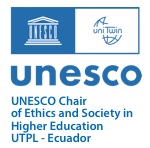Who go on to pursue higher education in China? Case study at Shandong University
Abstract
Higher education aims to cultivate the varied human talents by specializing them for the complex labor field. We must pay more attention to university education, analyzing the factors that influence students to decide for study or work. This paper analyzes the Chinese university from the perspective of anthropology. The factors that influence higher education have been considered, which are studied articulated in three aspects: the gender of the students; the socio-economic level of the families (parents of the students); and the level of education or degree of academic training of the parents.
Downloads
References
Bloj, Cristina. (2017). Trayectorias de mujeres: educación técnico-profesional y trabajo en la Argentina. Santiago CEPAL. https://repositorio.cepal.org/handle/11362/41230.
Bourdieu, Pierre. (1995). Las reglas del arte: génesis y estructura del campo literario. Anagrama.
Bourdieu, Pierre. (2012). «Ökonomisches kapital, kulturelles kapital, soziales kapital». In Handbuch Bildungs-und Erziehungssoziologie pp. 229-242. VS Verlag für Sozialwissenschaften, Wiesbaden.
Bourdieu, Pierre. (2017). «Habitus». In Habitus: A sense of place Sep (19): pp. 59-66. Routledge. doi: 10.4324/9781315253701-7.
Clemente, Aina Tarabini-Castellani, and Marta Curran Fàbregas. (2015). «El efecto de la clase social en las decisiones educativas: un análisis de las oportunidades, creencias y deseos educativos de los jóvenes». Revista de investigación en Educación, 13(1): pp. 7-26. http://webs.uvigo.es/reined/.
Coleman, James S. (1968). «Equality of educational opportunity». Integrated Education, 6(5): pp. 19-28. doi: 10.1080/0020486680060504.
Domina, Thurston, AnneMarie Conley, and George Farkas. (2011). «The link between educational expectations and effort in the college-for-all era». Sociology of Education, 84(2): pp. 93-112. doi: 10.1177/1941406411401808.
Fernández-Huerga, Eduardo. (2010). «La teoría de la segmentación del mercado de trabajo: enfoques, situación actual y perspectivas de futuro». Investigación económica, 69(273), 115-150. doi: 10.22201/fe.01851667p.2010.273.24253.
Gao Guizhong, & Lv Guoguang. (2011). «Family Cultural Capital on Tibetan Students’Performance Impact». Journal of Qinghai University for Nationalities, 31(4): pp. 60-64. doi: 10.3969/j.issn.1007-0117.2011.04.017.
Guo Congbin, & Min Weifang. (2006). «The impact of family economic and cultural capital on children's educational opportunities». Higher Education Research, 27(11), pp. 24-31. http://www.cnki.com.cn/Article/CJFDTotal-HIGH200611004.htm.
Han Tingting. (2017). «The correlation studies of female educational attainment and occupational status». Master's thesis, University of Shenyang Normal. http://cdmd.cnki.com.cn/Article/CDMD-10166-1017068180.htm
Huang Aihua. (2003). «Women's Higher Education Equity: Problems and Countermeasures». Modern education science, 02: pp.22-26. http://www.cnki.com.cn/Article/CJFDTotal-JLJK200303005.htm
Instituto MyCOS. (2019). 2019 Libro Azul del Empleo. Editorial de literatura de ciencias sociales.
Kuandachakupt, Supriy. (1995). «The impact of population change on household investment in education in Thailand». PhD diss, University Microfilms International. https://elibrary.ru/item.asp?id=5647847.
Liu Linlin. (2018). «Research on the Development of Female Higher Education in China». Master's thesis, Tiangong University. http://cdmd.cnki.com.cn/Article/CDMD-10058-1018175828.htm
López, Soraya Leyva, and Antonio Cárdenas Almagro. (2002). «Economía de la educación: capital humano y rendimiento educativo». Análisis econòmico, 17(36): pp. 79-106. https://www.redalyc.org/pdf/413/41303603.pdf.
Martínez García, José Saturnino. (2007). «Clase social, género y desigualdad de oportunidades educativas». Revista de Educación, 342: pp. 287-306. http://disde.minedu.gob.pe/handle/123456789/1281.
Maurin, Eric. 2002. «The impact of parental income on early schooling transitions: A re-examination using data over three generations». Journal of Public Economics, 85 (3): pp. 301-32. doi: 10.1016/S0047-2727(01)00131-1.
Merton, Robert. K. (1968). «The Matthew effect in science: The reward and communication systems of science are considered». Science, 159(3810): pp. 56-63. doi: 10.1126/science.159.3810.56.
Ministerio de Educación de la República Popular de China. (2019) «Departamento de educación, junto con los departamentos pertinentes, gestiona de manera integral el entorno del examen y protege completamente la seguridad del examen de ingreso a la universidad en 2019». http://edu.people.com.cn/n1/2019/0605/c1006-31122228.html.
Ministerio de Educación de la República Popular de China. (2018) «Departamento de Planificación del Desarrollo del Ministerio de Educación: Informe anual sobre el desarrollo de la educación nacional en el año 2018» http://www.moe.gov.cn/jyb_sjzl/sjzl_fztjgb/201907/t20190724_392041.html.
Nash, Margaret A., ed. (2017). Women’s Higher Education in the United States: New Historical Perspectives. Springer.
Nye Jr, Joseph. S. (2004). Power in the global information age: From realism to globalization. Routledge, London. doi: 10.5555/983472.
Oficina Nacional de Estadística de China. (2020). «2019 Ingresos y gastos de consumo de residentes». http://www.stats.gov.cn/tjsj/zxfb/202001/t20200117_1723396.html.
Rojas, Mariano, Humberto Angulo, and Irene Velásquez. (2000). «Rentabilidad de la inversión en capital humano en México». Economía mexicana. Nueva época, 9(2): pp. 113-142. http://aleph.academica.mx/jspui/handle/56789/4204.
Sawada, Yasuyuki, y Michael Lokshin. (2000). «Household Schooling Decisions in Rural Pakistan». Working Paper, (2541). Washington, D.C.: Distributed by ERIC Clearinghouse, http://hdl.handle.net/10986/15745.
Sawada, Y., & Lokshin, M. (2009). «Obstacles to school progression in rural Pakistan: An analysis of gender and sibling rivalry using field survey data». Journal of development Economics, 88(2): pp. 335-347. doi: 10.1016/j.jdeveco.2008.03.002.
Schultz, Theodore. W. (1971). Investment in Human Capital. The Role of Education and of Research, https://eric.ed.gov/?id=ED105584.
Takashi Sasaki. (1984). «Ikuo Amano, "Education and Selection", "Social History of Exams: Examination, Education, and Society in Modern Japan"». Educational research, 51 (3): pp. 329-330. doi:10.11555/kyoiku1932.51.329.
Wu Wei, and Qiu Wenjie. (2019). «Analysis of the Enrollment Opportunity of Female Higher Education in Countries along the Belt and Road». Higher Education Research, 09: pp.14. http://www.cnki.com.cn/Article/CJFDTotal-HIGH201909014.htm.
Copyright (c) 2020 © Analysis

This work is licensed under a Creative Commons Attribution-NonCommercial-NoDerivatives 4.0 International License.








